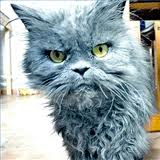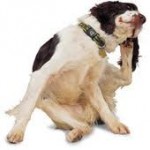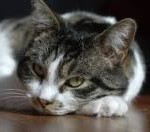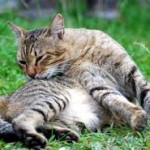Fleas, fleas, fleas!
Perhaps fleas have never had a good press. Having been vilified last century as vectors of The Black Plague, the greatest human disaster in history, they have since been associated with uncleanliness and used in taunts and insults throughout the ages. Fortunately, through improved hygiene and public health, the fleas are not often vectors of anything worse than tapeworm in cats and dogs in modern times. In Australia, myxomatosis was introduced to control rabbit populations and rabbit fleas will transmit this to other rabbits.
Most fleas have a preferred species host but they will all bite any creature with a pulse if it means getting fed.
Most of us will know the flea as the pest that causes Flea Allergic Dermatitis in cats and dogs and severe irritation to anyone else by biting. In very severe allergies the victims can sometimes behave like they are on fire.
In very severe infestations, these ‘wingless siphons’ can even cause death by anaemia in small weak animals but fortunately the infestation is usually addressed long before this disaster arises.
There seems to be resurgence in flea problem along with the wet warm weather we are experiencing and our milder Winters in recent years, Downunder. Many pets live indoors these days, so fleas have further opportunities, year round, to wreak havoc.
There was a brief time when the newest generation flea products containing growth retardants, hormones and ivermectins seemed to halt the assault.
The fleas are now either no longer intimidated by these products or people have stopped using them; perhaps both.
I used to recommend the monthly spot on flea products and they used to work very well. They were very much safer in the short term than the serious toxins of the past but the long term effects are still being assessed. Nowadays I have clients who do not want to use any chemicals on their animals and I am similarly minded.
If I do use any chemical application, these days, it is permethrin, a water based synthetic pyrethrin. It is very toxic for cats and fish but has low absorption through skin and is safe to use frequently on dogs and horses for fly worry, ticks and fleas.
But there are natural and safer alternatives for flea control.
In most cases, there is no need to use chemicals on pets because the majority of fleas are in the environment and not on the pet.
The flea spends a relatively short time on the host, sufficient to mature and take a blood meal that will last it for its reproductive lifetime, off the host.
If the animal has a lot of fleas on them then you have a heavily infested house or garden!
For each flea there will be an estimated one hundred immature stages waiting to develop and take its place.
This is where we need to target our flea control if we are to have any success.
The best entirely non-toxic household practice will involve steam cleaning of carpets as the heat will kill flea eggs and larvae. Hot mopping vinyl or boarded floors with some eucalyptus oil in the water will assist in uncarpeted areas. Soft furnishing and bedding should be hot washed if possible and hot dried. Beating and hanging rugs, mats and bedding materials on the clothes line in UV sunlight will also kill immature flea stages.
Using Eucalyptus oil in the washing machine water will assist to kill immature stages and dust mites in bedding.
Fleas hatch with vibration so walking on carpets and in houses that have been vacant for a while will bring a mass of hatching. So too will vacuuming, which can be used to assist flea control by placing a flea collar inside the vacuum cleaner bag. This is the only application for these collars, according to me. I have seen too many cats develop severe wounds from trying to remove their own flea collars which are anathema to them.
Outdoors, the use of diatomaceous earth is effective but care must be taken to avoid inhaling the dust particles. These dust particles mechanically kill fleas so can cause irritation to skin and lungs in mammals. It is an effective and safe environmental control sprinkled around the back yard. Swimming pool filters use extremely fine particles of diatomaceous earth and it is safer to source a supply of coarser particles if you are using it for flea control. Owing to the mechanical irritant effect, I would still recommend wearing a mask and gloves if you use this product even though it is entirely natural and non toxic. Keeping lawns mown short also assists drying and sun killing of fleas, as does removing leaf and building debris. Airing pets’ beds will help, especially if they can be placed for a while in direct sunlight.
The natural on-pet control measures that have been suggested include
• Rosemary wash, steeping 2 cups of fresh rosemary in boiling water and when cooled, bathing the pet all over
• Lemon wash, lemon and rind sliced into boiling water and using it when cooled as a topical wash on pets. Also good skin tonic in general
• Apple cider vinegar, half teaspoon added to pets drinking water or applied 50:50 dilution for skin itching and flea repelling
• Lavender essential oil, a drop or two on the tail base and neck. Caution with cats, safe but they can salivate excessively after licking skin.
• Brewers Yeast added to food as a sprinkle. This is a vitamin B1 effect that can also be achieved with B1 supplementation directly in tablet form. (Betamin from chemists, half tablet daily in food or by mouth)
• Garlic in the pets’ food is reported to have flea repellant properties, as long as it doesn’t repel you. Dogs and cats will tolerate garlic, cats less so. It can also be used topically. Garlic is also an excellent natural antibiotic.
• Oil, any edible oil but preferably flax, coconut or olive oil can help to detract fleas from infesting the pet. The animals may have to be washed afterwards and if cats lick themselves excessively to clean off the oil they can develop skin irritations making it the least attractive control measure, next to essential oils, in this species. Topical coconut or almond oil is an excellent soother for itchy spots.* Bathing is also a good measure for many animals, use gentle mild pet shampoo specially formulated for animal skin pH like episoothe or allerderm oatmeal shampoo. The fleas can be tipped out with the bath water. Soap nuts are probably the best all round wash and healing solution for flea allergic pets.
All of the above water based natural washes are safe for all species of any age.
 Paws to Heal uses and dispenses Flea Nosode as an adjunct to flea control. This is a homeopathic preparation containing dog and cat flea 30C plus Green Essence Australia Bush Essence for parasite control.
Paws to Heal uses and dispenses Flea Nosode as an adjunct to flea control. This is a homeopathic preparation containing dog and cat flea 30C plus Green Essence Australia Bush Essence for parasite control.
Keeping your pet as healthy as possible on the inside will help to keep skin and immunity strong. Natural raw food diets and raw meaty bones are best diets for optimal health. Most animals will have a natural ability to deal with the occasional flea but should flea numbers get out of control it is imperative to address environmental concerns as soon as you notice things getting out of hand.
It is also important to treat for tapeworm in flea infested pets.







January 7th, 2013 at 3:17 am
Please bear in mind Pool Grade Diatomaceous Earth has been treated with chemicals and heat. It is NOT safe to use on animals nor effective. Diatomaceous Earth or Fossil Shell Flour that is food grade would be the best option. Safety precautions handling dust should be taken.
December 17th, 2012 at 1:12 am
There are a few plants that will deter fleas. I have planted as many as I could get partly because the variety makes for a nice garden and partly for a greater effect. Also most of them are herbs and therefore can also be used in cooking.
They are:
All varieties of Mint
Catnip
Sage
Rosemary
Chamomile
Lavender
Lemon Grass
September 26th, 2011 at 1:15 am
I tried garlic on my dog and it worked very well. Thanks for the tip!
March 17th, 2011 at 6:45 am
Dear Saranyu
I do not like applying Advantage to my cats
Tabby particularly dislikes it.
After in took the enamel off the washing machine I was particularly concerned.
I have planted pennyroyal at the back door and I am going to try the Australian bush flower Essence (Green) I have ordered some essences and they arrive early next week.
It seems fleas like to live in the pea straw which my garden likes so much.
I am going to try some of your other suggestions for cats as well with this weather fleas are a huge problem.
I also was very grateful for your help with my dominant cat Chief. I am sure it helped.
I now feed him after Tabby also
I have been giving Tabby Bush Flower Emergency essence and have ordered Clear and Calm also.
Your web site is a great help and inspiration
Thankyou
Jennifer Hornsey